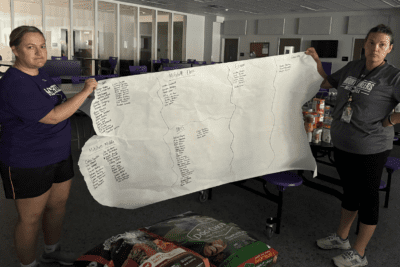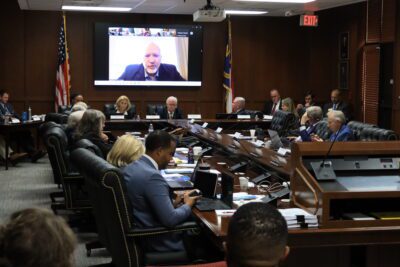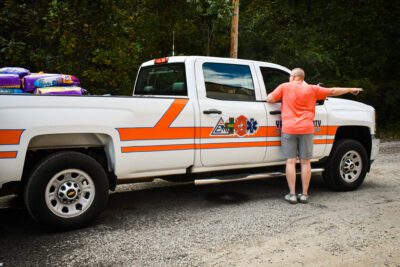
|
|
Update, Oct. 25 at 11 a.m. — Gov. Roy Cooper signed the second relief bill into law on Friday, Oct. 25.
“Western North Carolina needs significant investments to recover fully from the worst storm our state has ever seen,” Cooper said in a statement. “Legislators have taken a small step here and should follow it with a more comprehensive package to help families, businesses and communities build back stronger.”
The Republican-led General Assembly unanimously passed a $604 million Hurricane Helene relief package on Thursday afternoon, marking the second relief bill passed to aid recovery in western North Carolina.
The bill includes various education allocations, including $65 million to the Department of Public Instruction (DPI), $16.75 million to the N.C. Community College System (NCCCS), and $10 million toward disaster relief for child care centers and family child care homes.
“This will be a long recovery, and the legislature will not lose sight of rebuilding the region and fixing the damage,” a press release from Sen. Phil Berger, R-Rockingham, said. “Our second relief package puts the General Assembly’s total commitment so far at almost $900 million, and that will only grow as we continue to evaluate and repair the damage.”
The first relief bill, which included $273 million in relief funds, was passed unanimously by the General Assembly on Oct. 9 and signed into law by Democratic Gov. Roy Cooper on Oct. 10.
Among other things, the initial bill included $250 million to the state’s Department of Public Safety and Division of Emergency Management, $16 million to DPI to replace lost compensation of school nutrition employees, and school calendar flexibility and compensation for public school districts and employees impacted by Helene closures.
Both relief bills are being funded through the state’s savings reserve, which has approximately $4.47 billion in it, according to the Office of State Budget and Management. Republican leaders have said the state also has about $700 million in a separate disaster relief fund.
On Wednesday, Cooper released his own disaster recovery proposal ahead of the General Assembly’s session, calling for $3.9 billion in state funds to go toward relief aid. His proposal included $282 million toward education recovery, along with $36 million for child care center disaster relief. Cooper’s proposal said that initial damage estimates for Helene are $53 billion, “roughly three times Hurricane Florence estimates in 2018 and the largest in state history.”
Senate Republicans criticized the governor’s request for increased funding for the N.C. Office of Recovery and Resiliency in a press release on Wednesday, indicating that state Republicans are unlikely to prioritize the governor’s proposed relief items.
On Thursday, House Democratic Leader Rep. Robert Reives, II, D-Chatham, sent an email statement calling for future relief bills to include bipartisan input.
“This second disaster relief package for Western North Carolina is sorely needed. However, I am disappointed that House Democrats were not directly involved in writing this legislation,” Reives said.
On Thursday, House Speaker Rep. Tim Moore, R-Cleveland, told House members to communicate any relief requests with staff.
“This is probably going to define a great deal of the next legislative session too, in working through the relief packages,” Moore said. “This is part of a larger process that will continue… and so members should anticipate that we’ll take up further bills. I would ask those members, as you’re seeing things, please make sure that our staff knows anything that you see needs to be addressed, because we are taking all suggestions and working to come up with a solution.”
A veto override of the mini budget was also originally on the House’s calendar for Thursday, but was moved to be discussed on Nov. 19. The mini budget, which included enrollment growth funds for K-12 schools and community colleges, was vetoed by Cooper due to its expanded funding for private school vouchers and requirement for local sheriffs to cooperate with ICE.
Below, you can find a look at the education items in the relief package, including allocations for K-12 schools, community colleges, and child care.
You can read the money report here, and the bill text here.
More K-12 relief
Of the $65 million allocated to DPI in the most recent bill, $50 million will go toward repair and renovation of impacted facilities, for damage not covered by insurance or federal aid.
DPI’s initial relief request asked for $150 million toward recovery funds.
Here is what the other $15 million for DPI will go toward:
- $5 million toward replacement of school technology in impacted schools.
- $5 million to repair or replace food nutrition equipment, food, and food nutrition supplies “in public school units participating in the National School Lunch Program or School Breakfast Program in counties with a federal disaster declaration due to Hurricane Helene.”
- $5 million for mental health services, “including telehealth and contracted services, for students and staff in public school units impacted by Hurricane Helene.” According to the bill, DPI must determine the amount to be allocated to each eligible public school unit by allocating each an initial amount of $30,000, then distributing the remaining funds on the basis of allotted average daily membership (ADM).
The relief package also grants additional calendar flexibility to impacted districts, up to 20 additional waived days. Under the bill, state Superintendent Catherine Truitt can approve additional school calendar flexibility “in the most impacted school districts.”
There is also a testing admissions waiver for certain educator preparation programs (EPPs), for admission for the spring semester of the 2024-25 academic year only.
Finally, the bill requires that students who withdrew from a charter school due to the impacts of Helene are considered by the charter school “to have been continuously enrolled for the entire 2024-2025 school year for admission purposes.”
Per the bill, displaced charter school students will not be required to reapply to the school for the 2025-26 school year.
Relief for community colleges
The first relief bill passed earlier this month did not include relief funding for community colleges, but bill passed on Thursday allocates $16.75 million to the NCCCS.
The NCCCS has not published a specific funding request, but said during last week’s State Board of Community Colleges meeting that it is asking state lawmakers for student support funds and stabilization dollars due to enrollment loss.
The second relief bill did not include stabilization dollars. After Hurricane Florence, the General Assembly allocated $6.4 million to the NCCCS to offset enrollment losses nearly a year after the hurricane.
The bill establishes a Hurricane Helene Emergency Grant Program for Postsecondary Students to provide emergency scholarship grants of up to $2,500 “per student to eligible postsecondary students who have suffered financial hardship due to the damage and destruction from Hurricane Helene.”
There is also $10.5 million in funding for emergency grants for affected community college students “for tuition, fees, and emergency expenses that impact a student’s ability to remain enrolled.”
The package also includes $5 million toward spring 2025 tuition grants for eligible students at six community colleges “which were designated most or medium impacted by the Community College System Office:” Asheville-Buncombe Technical Community College, Blue Ridge Community College, Haywood Community College, Mayland Community College, McDowell Technical Community College, and Western Piedmont Community College.
Students enrolled in a curriculum or continuing education course at the above community colleges are eligible for the grant, per the bill.
“In the event there are not sufficient funds to provide the full tuition grant amount to each eligible student as provided by this section, each eligible student shall receive a tuition grant equal to the pro rata share of funds available,” the bill says.
Finally, the bill also includes $1.25 million to expand mental health services for students and staff at impacted communities colleges.
Here’s a look at other postsecondary items included in the bill:
- $3.5 million “to the North Carolina State Education Assistance Authority (SEAA) for the Need-Based Scholarship for Public Colleges and Universities program to make additional award funds available in FY 2024-25, which will be used to provide additional financial aid to eligible disaster-impacted students. SEAA is also directed to use an estimated $15.6 million in unobligated funds in the Scholarship Reserve Fund for Public Colleges and Universities to distribute awards for this purpose.”
- $5.5 million in spring 2025 tuition grants for eligible students at UNC-Asheville.
- $5 million for emergency grants for eligible students in the UNC System.
- $1 million for emergency grants for eligible students at private colleges.
- $5 million toward capital recovery funds for impacted UNC System institutions.
NCCCS President Jeff Cox issued a statement Friday thanking state leaders.
“The $10.5 million in emergency grants, along with critical funding for tuition and mental health services, will be instrumental in helping our students and colleges recover,” he said. “With my deep connection to Western North Carolina, I’ve seen the resilience of these communities firsthand, and this support will help ensure our colleges remain a cornerstone of recovery and rebuilding.”
Child care relief
The first relief bill passed earlier this month did not include any child care relief funding, but the relief package passed on Thursday includes $10 million in child care center disaster relief.
The initial bill did allow the Department of Health and Human Services (DHHS) to “temporarily waive or modify certain mandatory standards for a license for child care facilities in an area impacted by Hurricane Helene.”
Early childhood leaders have asked for funding to go toward capital costs, facility repairs, equipment and materials, and continued teacher pay, EdNC previously reported.
According to Cooper’s proposal, there are 55 child care centers in western North Carolina that are damaged and unable to reopen.
The funds allocated this week will go to the DHHS’ Division of Child Development and Early Education “for the North Carolina Partnership for Children to distribute funds to Smart Start Local Partnerships that serve counties with a federal disaster declaration due to Hurricane Helene.”
“Partnerships will use the funds for affected child care centers and family child care homes to provide assistance in reopening and maintaining operations, including, but not limited to, cleaning, repairs, and relocating,” the money report says.
The package also allocates $3 million to DHHS to distribute funds to county departments of social services “to provide essential services and supports to children involved in the child welfare system who have been impacted by Hurricane Helene.” There is also an additional $1 million in receipts toward this item.
Other highlights
The relief package also includes $75 million in additional funding for state matching funds for federal disaster assistance programs, and $50 million to North Carolina Emergency Management (NCEM) “for state agencies and units of local government in counties with a federal disaster declaration due to Hurricane Helene for unmet needs not covered by insurance or available federal aid.”
There is also $100 million to provide emergency bridge loans to local governments for water and wastewater infrastructure repairs, along with $100 million for a cash flow loan program to support governments in impacted counties.
Here are some other highlights:
- $25 million for mental health crisis supports and for support for individuals with intellectual and development disabilities.
- $20 million in matching federal funds for the administrative expenses incurred in operating D-SNAP, a federal program to provide food assistance to low-income households with food loss or damages caused by Hurricane Helene. Federal DSNAP benefits are estimated to exceed $200 million, per the bill. The bill also includes $10 million in receipts toward this item.
- $50 million to Golden LEAF for small business loans in impacted counties, and $5 million to Visit NC to promote western North Carolina tourism.
- $5 million to the NCEM for floodplain mapping in counties impacted by Helene to “be used to revise existing floodplain maps according to new data and imagery which will capture changes in the region such as new high-water marks.”
- $1 million to provide rental assistance “to households who have suffered hardship due to Hurricane Helene and are facing a housing crisis, such as imminent risk of eviction.”
Finally, in a separate bill, the General Assembly voted to require 13 county boards of elections to open at least one early voting site for every 30,000 registered voters.
These 13 counties were identified by the State Board of Elections in its Oct. 7 resolution outlining Helene voting provisions: Ashe, Avery, Buncombe,Haywood, Henderson, Madison, McDowell, Mitchell, Polk, Rutherford, Transylvania, Watauga, and Yancey.
